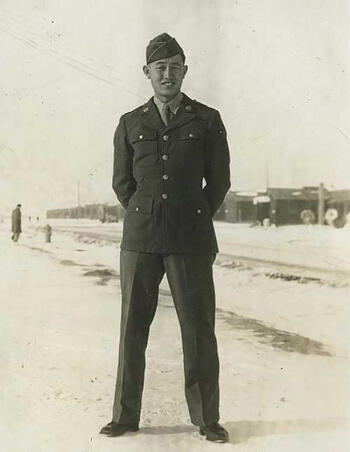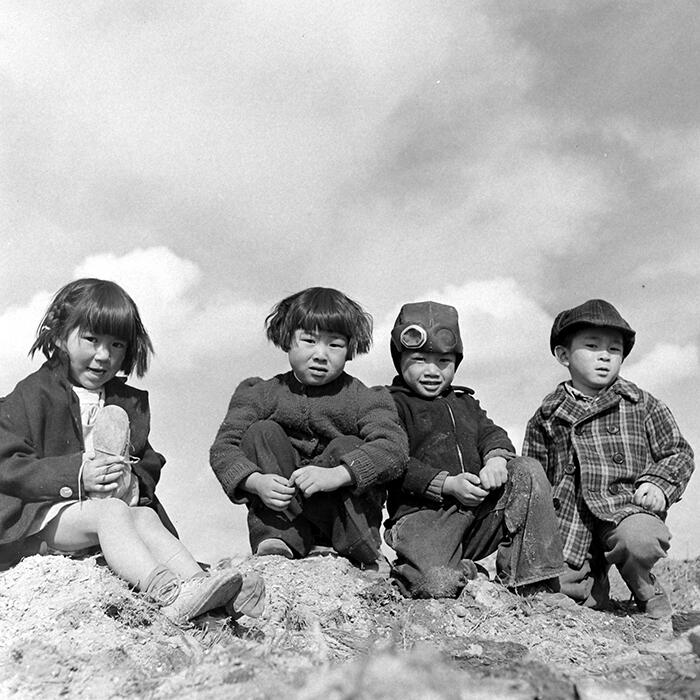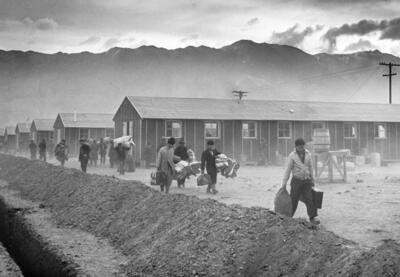Stanley Hayami was 16 when his family was incarcerated at Heart Mountain—a concentration camp so large that its 10,000-plus Japanese American inhabitants made up the third-largest town in Wyoming.
Pictured Above: The first group of 82 Japanese Americans arrive at the Manzanar concentration camp (or “war relocation center”) in Owens Valley, California, carrying their belongings in suitcases and bags on March 21, 1942. Manzanar was one of the first of 10 U.S. concentration camps, and its peak population, before it was closed in November 1945, was over 10,000 people.
Hayami was one of approximately 1,500 students at Heart Mountain. His journal entries and drawings, in many ways, reflected the typical musings and anxieties of a teenager. He worried about whether his body would grow, about his grades, about sports and what his future held. But as a Japanese American incarcerated as a result of President Franklin Roosevelt’s Executive Order 9066—an order that cast Japanese Americans as potential culprits of espionage and violence during World War II—Hayami held anxieties unique to a child coming of age under the shadows of suspicion and xenophobia.
His story, like most stories of the 33,000 enlisted U.S. Army Nisei soldiers and 120,313 Japanese Americans incarcerated in 10 U.S. camps, remains woefully forgotten in the history books. A new education initiative from the National Veterans Network (NVN) and the Smithsonian’s Asian Pacific American Center (APAC) aims to change that, utilizing their historical resources and the stories of Japanese Americans to create lessons often missing in U.S. history curricula—and connect those lessons to lived experiences of injustice today.

“I hope the war ends this year,” Hayami wrote on New Year’s Day in 1943. “I hope I’m out of here and a free man by ’44.” His resolutions included vows “to be more understanding of others,” and, as any student might wish, to “learn as much as I can.”
In 1944, Hayami enlisted in the U.S. Army, joining the segregated 442nd Regimental Combat Team in Europe.
For a while, Hayami’s family continued to receive his letters and doodles, reflections of his enduring lightheartedness. Hayami died while administering first aid to wounded soldiers on April 23, 1945. His family, awaiting his letters, received the telegram on May 9—one day after the U.S. had celebrated its victory in Europe.
An Education Project Designed to Preserve the Stories
“Personal stories have a way of connecting to people, connecting to students,” says Christine Sato-Yamazaki.
Sato-Yamazaki is the executive director of the National Veterans Network, an organization that advocates for the preservation of Nisei soldiers’ stories and strives to provide education that will utilize those stories to prevent future injustices.
After previously collaborating with the Smithsonian’s APAC on the digital exhibition that accompanied the 2011 Congressional Gold Medal awarded to Japanese American soldiers, Sato-Yamazaki saw an opportunity. The exhibition—featuring the stories of 12 enlisted Japanese Americans—had received great feedback, including San Francisco Unified School District sharing the resource with its educators. But it wasn’t being used as Sato-Yamazaki had hoped.
“Because for us,” Sato-Yamazaki explains, “it starts in the classroom.”
She imagined that the wealth of primary documents and biographical materials could inform an expanded curriculum with national reach. And the Smithsonian was the perfect partner.
“There’s so many hard lessons we learn from American history, the great American story,” says Andrea Kim Neighbors, manager of education initiatives at the Smithsonian’s APAC. “The story of the Japanese American camps is a key one. … This is a story that needs to continuously be told.”
Initially, the Smithsonian and the NVN contracted out the lessons, which aligned information about Japanese American incarceration and those who served in the military with social studies standards. But it was clear, early, that they would need educator feedback.
“We decided we really needed teachers to be involved with this process and to shape it, to create it,” Neighbors says. “Because they know how it will be applied and learned in the school classrooms.”
At first, four educators were brought to the Smithsonian APAC in Washington, D.C., to do a “sandbox”—providing input on already-designed lessons.
“But it turned into much more than that after we all got together,” remembers Brian Mason, a middle school teacher in Virginia’s Fairfax County. The lessons required a lot of background knowledge, and the educators spotted a disconnect between ideas and usability.
“We all agreed that there was something missing,” says Erin Miranda, who teaches fourth and fifth grade in San Francisco. “It was great to be there and be so valued as teachers trying to figure it out in real life, thinking about how we could make this accessible for as many classrooms, as many teachers as possible.”
To the credit of the Smithsonian and the NVN, they scrapped the original lessons. Three educators, including Mason, Miranda and D.C.-based elementary teacher Jon Berg, stayed on to design and pilot new material. The team worked for almost two years.
The result is two activity books, one each for elementary and middle school students. Each book foregrounds the personal stories of Japanese Americans in teaching students this history, present-day implications and what these stories have to say about our values.
“We were super excited about what the message was,” Mason says. “And to get it out.”
The materials are available—to download, print or order—through the NVN’s website. And at both the elementary and middle school levels, they offer activities that explore the interconnection between the personal and the political, between this terrible chapter of our nation’s past and the need for righteous action in our nation’s present.
Teaching Elementary Students About the Japanese American Experience During World War II
“To teach history we have to be honest,” Erin Miranda says. “And there’s a way to be age-appropriate about it.”
Many elementary educators may balk at the idea of broaching the heavy subjects of racism, incarceration and war with young learners. But Berg insists, “If you are purposefully leaving out components of our shared history, you are actively doing a disservice to the students you’re teaching.”
Rather than avoiding tough topics, the activities created by Miranda and Berg are clearly designed to use developmentally appropriate questions to help students understand this history.
“What we essentially agreed upon was that we can’t underestimate these young children at a pivotal time when we can teach them about character,” Sato-Yamazaki explains. “We can teach them about fairness. We can teach them about compassion.”
The elementary activity book offers lessons for grades 2-5. Focusing on age-appropriate concepts of fairness, making friends, moving, artistic expression and team building, the activities inspire the exploration of two key questions: How can events from the past inform the decisions we make today? And why is it important to think critically about the consequences of racial discrimination?
The story of Stanley Hayami features prominently. Inspired by his doodles, students consider what it means to make art with limited supplies. Inspired by his love of sports, students consider what it means to create communities during a time of struggle. Students confront the uncertainties of moving, the pains of being forced to leave pets and culturally significant heirlooms behind, and the stressors of doing schoolwork when your future freedom isn’t guaranteed.
According to Miranda, students were quick to empathize upon learning these stories—and quick to make deeper connections.
“Realizing the resilience that people who lived through that experience had [allowed] students to recognize something in themselves,” Miranda says. For some, she said, they recognized their own resilience, the strength they may have to endure such a situation—a virtue known in Japanese as gaman. For others, they recognized they “can be the agents of change.”
It’s something that was really important to Jon Berg as he helped design the activities.
“The ultimate goal is students who are engaging in these lessons, really caring and connecting and empathizing with the people that they’re learning about,” Berg says. “And then, that connection driving them toward feeling empowered to act, to ensure that a similar thing doesn’t happen in the future.”
That empowerment opens the door, as students grow, toward an understanding of the many forms resistance, activism and patriotism can take—in both the past and the present.

Taking It a Step Further in Middle School
In Brian Mason’s seventh grade class at Herndon Middle School, a song was playing. Students read along with the lyrics:
And some folks didn’t even have a suitcase to pack anything in.
So two trash bags is all they gave them.
And when the kids asked, ‘Mom, where are we going?’
Nobody even knew what to say to them.
“I could immediately see from their body language,” Sato-Yamazaki remembers. “They perked up. And they listened.”
The rap song “Kenji,” by Linkin Park’s Mike Shinoda, chronicles his father’s family’s experience with incarceration in Poston, Arizona. The lyrics are included in an interactive three-day unit that allows middle school students to consider three distinct stories of Japanese American history and why they remain relevant today.
In learning more about the hidden histories of Japanese American people, Mason says he learned the importance of asking particular questions to design the activities: What voices are missing? Whose voices are present? Whose voice didn’t appear in a reading?
“I think if you just ask those questions and you are an educator who is a lifelong learner yourself, and you’re open to change and flexibility, I think that’s going to be enough,” he says.
Students are introduced to three key figures in the middle school activity book: Daniel K. Inouye, a 442nd veteran who went on to serve in the United States Senate; Terry Nakanishi, who enlisted in the Women’s Army Corps; and Fred T. Korematsu, who challenged the legality of incarceration all the way to the U.S. Supreme Court.
Mason says many kids really latch onto the injustice of Korematsu’s story; his incarceration was ruled as justifiable in one of the Supreme Court’s most infamous decisions. Mason hopes educators will see the activities as providing students with multiple perspectives from which they can choose to learn or connect.
The vastly different experiences of Inouye, Nakanishi and Korematsu—coupled with present-day examples of incarceration and xenophobia—allow middle school students to confront complicated questions about what it means to be patriotic or to fight injustice.
A key outcome of the activity book Mason designed is to look critically at “what it means to be an American,” connecting the Japanese American experience to other instances in which people’s Americanness was questioned because of their identities. More specifically, Mason hopes the middle school lessons allow students to see World War II through a different lens, not just through the experiences of white people who dominate textbooks.
“You have American history, where there was this one narrator, right?” Mason explains. “That narrator told of the American experience, and it was largely singular and you had to force yourself to fit into it or you just didn’t. And you were the ‘other.’ And I think the most broad-level goal that we hope to achieve with this is making people realize that America is not one story with one narrator. That it’s a collection of short stories from different voices and different times and different people who have very different experiences but have something that makes them uniquely American.”
Both Sato-Yamazaki and Neighbors were able to witness Mason’s classroom as he piloted the lessons. They walked away impressed—and hopeful.
“Students on their own were able to make really incredible connections with what they see happening on the news or what they heard,” Neighbors says, noting that students quickly recognized the gross injustice of what happened to Japanese Americans.
“I think [the lessons] started to really impact students’ awareness of race and justice in their school communities and in what they see happening across the country.”
The Past Is Present; The Past Is a Present
When the educators began piloting the activity books in their classrooms, that work coincided with national news about the increased incarceration of children and families at the U.S.-Mexico border.
Berg says that creating classroom cultures that value student voice and participation, and where students feel comfortable sharing, will often lead students to make present-day connections on their own—connections that are vital for building a better future.
“The reason why I believe this story is so important to tell,” Neighbors says, “is that [Japanese Americans] were wrongfully imprisoned because of how they look, because of misinformed, racially biased decisions to imprison people because of fear they might do something harmful. That was never proven to be true, and I think there’s so much we can still learn from that. …
“We see this happening now on the border, families separated forcefully. We see children in cages. And what really makes me sad about that is, as a nation, we still haven’t learned from this at all.”
Since the lessons were first piloted amid incarcerations at the border, history has echoed in different ways. The coronavirus pandemic laid bare the quickness with which anti-Asian xenophobia and racism can re-emerge as a scapegoat in a time of crisis. For Sato-Yamazaki, it was hard not to note the comparison.
“[Japanese Americans] were looked upon with suspicion,” she says. She recalls how many were spit upon in public, how those who enlisted in the Army during World War II often did so to prove their loyalty and protect their families from undue speculation.
“Seeing the increase in discrimination does bring it back,” Sato-Yamazaki admits. “This feeling that we’re not looked upon as Americans again.”
A descendant of incarcerated Japanese Americans, Sato-Yamazaki notes the importance of telling her son about his family history.
“It’s about making sure that history is passed on,” she says. “It’s very personal for me, but it’s much larger than that. It’s an American story that should be told.”
For many of Erin Miranda’s students, the stories of Nisei soldiers and incarcerated Japanese Americans is very personal as well—family stories, just a few generations old. Miranda teaches at Rosa Parks Elementary, home to a Japanese Bilingual Bicultural Program. She herself is the granddaughter of incarcerated Japanese Americans.
“It’s part of our local history,” she explains. Those who resisted or persisted through incarceration are part of the community’s past and inspire the community’s future.
One such person who visits the school is Dr. Satsuki Ina, an activist and community trauma expert whose family resisted incarceration. As co-chair of Tsuru for Solidarity—a direct-action group of Japanese American activists fighting racist detention and removal policies—she continues to advocate for victims of incarceration, including immigrants at the southern U.S. border.
And when Satuski Ina visits Rosa Parks Elementary, the thank you notes she receives illustrate the ways in which students can see her story as a lesson for their own lives.
“The message that she gets most often is that … they want to speak out,” Miranda says. “They want to do what they can, even if it’s not happening to them.”
It hasn’t always been common for Japanese American elders to share these stories or to advocate for their inclusion in education spaces. Sato-Yamazaki speaks of the incredible humility of Nisei veterans, of growing up as the granddaughter of a 442nd veteran but rarely hearing about his story.
Miranda admits that, for a long time, her mother—the child of incarcerated Japanese Americans—didn’t really talk about it.
But recently, Miranda’s mother retired and began volunteering to read books to elementary students. Miranda says she took notice of people, cultures and histories that hadn’t been represented in her classroom libraries as a student. She told her daughter, “Why can’t we have the Japanese American experience and internment camps also explained that way?”
Thanks in part to her daughter and this new initiative, more students will be introduced to that history. And while its continued relevance reveals painful, ongoing injustices, this newfound opportunity to teach it—thoroughly—also offers some hope.
“I think it’s because earlier generations weren’t ready to do that,” Miranda’s mother told her. “I think you’re doing the right thing. It’s your voice that can teach this to other generations.”

